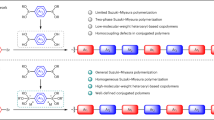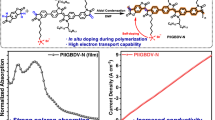Abstract
Postfunctionalization of aromatic C – H bonds at the main chains of π-conjugated polymers (CPs) is ideal for tuning various functionalities of precursor CPs because aromatic C – H bonds are the most common structures in their backbone. However, C – H activation reactions available in postfunctionalization methods remain limited. Here, we expand this limitation by performing electrochemical C – H phosphonylation of the main chain of poly(3-hexylthiophene) (P3HT). The introduction of phosphonate moieties into the main chain of CPs is potentially useful for improving their processibilities and imparting sensing abilities to them. Anodic phosphonylation of P3HT was successfully achieved using trialkyl phosphite as an electrically neutral nucleophile in the presence of nonnucleophilic dopants. The chemical structures and the optoelectronic properties of phosphonylated P3HT were characterized.
This is a preview of subscription content, access via your institution
Access options
Subscribe to this journal
Receive 12 print issues and online access
$259.00 per year
only $21.58 per issue
Buy this article
- Purchase on Springer Link
- Instant access to full article PDF
Prices may be subject to local taxes which are calculated during checkout





Similar content being viewed by others
References
Guo X, Baumgarten M, Müllen K. Designing π-conjugated polymers for organic electronics. Prog Polym Sci. 2013;38:1832–908.
Swager TM. 50th anniversary perspective: conducting/semiconducting conjugated polymers. A personal perspective on the past and the future. Macromolecules. 2017;50:4867–86.
Beaujuge PM, Reynolds JR. Color control in π-conjugated organic polymers for use in electrochromic devices. Chem Rev. 2010;110:268–320.
Ibanez JG, Rincón Marina E, Gutierrez-Granados S, Chahma M, Jaramillo-Quintero OA, Frontana-Uribe BA. Conducting polymers in the fields of energy, environmental remediation, and chemical–chiral sensors. Chem Rev. 2018;118:4731–816.
Gauthier MA, Gibson MI, Klok H-A. Synthesis of functional polymers by post-polymerization modification. Angew Chem Int Ed. 2009;48:48–58.
Blasco E, Sims MB, Goldmann AS, Sumerlin BS, Barner-Kowollik C. 50th anniversary perspective: polymer functionalization. Macromolecules. 2017;50:5215–52.
Goldmann AS, Glassner M, Inglis AJ, Barner‐Kowollik C. Post-functionalization of polymers via orthogonal ligation chemistry. Macromol Rapid Commun. 2013;34:810–49.
Günay KA, Theato P, Klok H-A. Standing on the shoulders of Hermann Staudinger: Post-polymerization modification from past to present. J Polym Sci, Part A: Polym Chem. 2013;51:1–28.
Michinobu T. Adapting semiconducting polymer doping techniques to create new types of click postfunctionalization. Chem Soc Rev. 2011;40:2306–16.
Michinobu T. Click functionalization of aromatic polymers for organic electronic device applications. Macromol Chem Phys. 2015;216:1387–95.
Shida N, Ninomiya K, Takigawa N, Imato K, Ooyama Y, Tomita I, et al. Diversification of conjugated polymers via postpolymerization nucleophilic aromatic substitution reactions with sulfur-, oxygen-, and nitrogen-based nucleophiles. Macromolecules. 2021;54:725–35.
Creamer A, Wood CS, Howes PD, Casey A, Cong S, Marsh AV, et al. Post-polymerisation functionalisation of conjugated polymer backbones and its application in multi-functional emissive nanoparticles. Nat Commun. 2018;9:3237.
Li Y, Vamvounis G, Holdcroft S. Tuning optical properties and enhancing solid-state emission of poly(thiophene)s by molecular control: a postfunctionalization approach. Macromolecules. 2002;35:6900–6.
Li Y, Vamvounis G, Yu J, Holdcroft S. A novel and versatile methodology for functionalization of conjugated polymers. Transformation of Poly(3-bromo-4-hexylthiophene) via palladium-catalyzed coupling chemistry. Macromolecules. 2001;34:3130–32.
Williamson JB, Lewis SE, Johnson RR, Manning IM, Leibfarth FA. C−H functionalization of commodity. Polym Angew Chem Int Ed. 2019;58:8654–68.
Shin J, Chang Y, Nguyen TLT, Noh SK, Bae C. Hydrophilic functionalization of syndiotactic polystyrene via a combination of electrophilic bromination and Suzuki–Miyaura reaction. J Polym Sci, Part A: Polym Chem. 2010;48:4335–43.
Lafitte B, Jannasch P. Phosphonation of polysulfones via lithiation and reaction with chlorophosphonic acid esters. J Polym Sci, Part A: Polym Chem. 2005;43:273–86.
Alexandratos SD, Strand MA, Quillen DR, Walder AJ. Synthesis and characterization of bifunctional phosphinic acid resins. Macromolecules. 1985;18:829–35.
Lochmann L, Fréchet JMJ. Controlled functionalization of polystyrene: introduction of reactive groups by multisite metalation with superbase and reaction with electrophiles. Macromolecules. 1996;29:1767–71.
Inagi S, Fuchigami T. Electrochemical post-functionalization of conducting polymers. Macromol Rapid Commun. 2014;35:854–67.
Kurioka T, Inagi S. Electricity-driven post-functionalization of conducting polymers. Chem Rec. 2021;21:2107–19.
Kurioka T, Nishiyama H, Tomita I, Inagi S. Improvement of current efficiency in anodic chlorination of Poly(3-hexylthiophene) by using a boron trifluoride-diethyl ether complex. ChemElectroChem. 2018;5:753–55.
Shida N, Okazaki D, Kurioka T, Nishiyama H, Seferos DS, Tomita I, et al. Anodic chlorination of selenophene-containing polymers: reaction efficiency and selective reaction of single segment in rod−rod diblockcopolymer. ChemElectroChem. 2017;4:1824–7.
Hayashi S, Inagi S, Hosaka K, Fuchigami T. Post-functionalization of poly(3-hexylthiophene) via anodic chlorination. Synth Met. 2009;159:1792–95.
Kurioka T, Komamura T, Shida N, Hayakawa T, Tomita I, Inagi S. Ordered-structure-induced electrochemical post-functionalization of Poly(3-(2-ethylhexyl)thiophene). Macromol Chem Phys. 2022;223:2100435.
Hayashi S, Inagi S, Fuchigami T. Efficient electrochemical polymer halogenation using a thin-layered cell. Polym Chem. 2011;2:1632–37.
Hayashi S, Inagi S, Fuchigami T. Synthesis of 9-substituted fluorene copolymers via chemical and electrochemical polymer reaction and their optoelectronic properties. Macromolecules. 2009;42:3755–60.
Qi Z, Rees NG, Pickup PG. Electrochemically induced substitution of polythiophenes and polypyrrole. Chem Mater. 1996;8:701–7.
Fabre B, Simonet J. Post-polymerization electrochemical functionalization of a conducting polymer: anodic cyanation of poly(p-dimethoxybenzene). J Electroanal Chem. 1996;416:187–89.
Fabre B, Kanoufi F, Simonet J. Electrochemical and XPS investigations of the anodic substitution of an electronic conducting polymer. Cyanation of poly[(1,4-dimethoxybenzene)-co-(3-methylthiophene)]. J Electroanal Chem. 1997;434:225–34.
Kurioka T, Shida N, Tomita I, Inagi S. Post-functionalization of aromatic C–H bonds at the main chains of π-conjugated polymers via anodic chlorination facilitated by lewis acids. Macromolecules. 2021;54:1539–47.
Inagi S, Hosaka K, Hayashi S, Fuchigami T. Solid-phase halogenation of a conducting polymer film via electrochemical polymer reaction. J Electrochem Soc. 2010;157:E88.
Inagi S, Koseki K, Hayashi S, Fuchigami T. Electrochemical tuning of the optoelectronic properties of a fluorene-based conjugated polymer. Langmuir. 2010;26:18631–33.
Song C, Swager TM. Conducting polymers containing peri-xanthenoxanthenes via oxidative cyclization of binaphthols. Macromolecules. 2009;42:1472–75.
Li Y, Kamata K, Asaoka S, Yamagishi T, Iyoda T. Efficient anodic pyridination of poly(3-hexylthiophene) toward post-functionalization of conjugated polymers. Org Biomol Chem. 2003;1:1779–84.
Effenberger F, Kottmann H. Oxidative phosphonylation of aromatic compounds. Tetrahedron. 1985;41:4171–82.
Yuan Y, Qiao J, Cao Y, Tang J, Wang M, Ke G, et al. Exogenous-oxidant-free electrochemical oxidative C–H phosphonylation with hydrogen evolution. Chem Commun. 2019;55:4230–33.
Long H, Huang C, Zheng Y-T, Li Z-Y, Jie L-H, Song J, et al. Electrochemical C–H phosphorylation of arenes in continuous flow suitable for late-stage functionalization. Nat Commun. 2021;12:6629.
Deng Y, You S, Ruan M, Wang Y, Chen Z, Yang G, et al. Electrochemical regioselective phosphorylation of nitrogen-containing heterocycles and related derivatives. Adv Synth Catal. 2021;363:464–69.
Guo X, Qin C, Cheng Y, Xie Z, Geng Y, Jing X, et al. White electroluminescence from a phosphonate-functionalized single-polymer system with electron-trapping effect. Adv Mater. 2009;21:3682–88.
Meng B, Fu Y, Xie Z, Liu J, Wang L. Phosphonate-functionalized donor polymer as an underlying interlayer to improve active layer morphology in polymer solar cells. Macromolecules. 2014;47:6246–51.
Wu C-S, Chou C-Y, Chen Y. Copolyfluorenes containing partially hydrolyzed phosphonate pendant groups: synthesis, characterization and application as electron injection layers for enhanced electroluminescence of PLEDs. J Mater Chem C. 2014;2:6665–74.
Hopkins J, Fidanovski K, Travaglini L, Ta D, Hook J, Wagner P, et al. A phosphonated Poly(ethylenedioxythiophene) derivative with low oxidation potential for energy-efficient bioelectronic devices. Chem Mater. 2022;34:140–51.
Abe Y, Amaya T, Inada Y, Hirao T. Characterization of self-doped conducting polyanilines bearing phosphonic acid and phosphonic acid monoester. Synth Met. 2014;197:240–45.
Amaya T, Sugihara R, Hata D, Hirao T. Self-doped polyaniline derived from poly(2-methoxyaniline-5-phosphonic acid) and didodecyldimethylammonium salt. RSC Adv. 2016;6:22447–52.
Amaya T, Kurata I, Inada Y, Hatai T, Hirao T. Synthesis of phosphonic acid ring-substituted polyanilines via direct phosphonation to polymer main chains. RSC Adv. 2017;7:39306–13.
Fuji K, Tamba S, Shono K, Sugie A, Mori A. Murahashi coupling polymerization: Nickel(II)–N-Heterocyclic carbene complex-catalyzed polycondensation of organolithium species of (Hetero)arenes. J Am Chem Soc. 2013;135:12208–11.
Lilley M, Mambwe B, Jackson RFW, Muimo R. 4-Phosphothiophen-2-yl alanine: a new 5-membered analogue of phosphotyrosine. Chem Commun. 2014;50:9343–45.
Tanaka S, Rosli SKB, Takada K, Taniai N, Yoshitomi T, Ando H, et al. Effects of bromination of poly(3-hexylthiophene) on the performance of bulk heterojunction solar cells. RSC Adv. 2017;7:46874–80.
Koo B, Sletten EM, Swager TM. Functionalized poly(3-hexylthiophene)s via lithium–bromine exchange. Macromolecules. 2015;48:229–35.
Frantz R, Durand J-O, Lanneau GF. Substituent effects of phosphonate groups electronic repartition of π-conjugated ferrocene analogues of stilbene. J Organomet Chem. 2004;689:1867–71.
Yebeutchou RM, Tancini F, Demitri N, Geremia S, Mendichi R, Dalcanale E. Host–guest driven self-assembly of linear and star supramolecular. Polym Angew Chem Int Ed. 2008;47:4504–08.
Amaya T, Abe Y, Hirao T. Deprotonation-induced efficient delocalization of polaron in self-doped Poly(anilinephosphonic acid). Macromolecules. 2014;47:8115–18.
Wu C-S, Su H-C, Chen Y. Synthesis and chemosensory application of water-soluble polyfluorenes containing carboxylated groups. Org Biomol Chem. 2014;12:5682–90.
Funding
This work was supported by Kakenhi Grants-in-Aid (JP19J23415 and JP20H02796) from the Japan Society for the Promotion of Science (JSPS) and a Support for Tokyo Tech Advanced Researchers [STAR] grant funded by the Tokyo Institute of Technology Fund (Tokyo Tech Fund).
Author information
Authors and Affiliations
Corresponding author
Ethics declarations
Conflict of interest
The authors declare no competing interests.
Additional information
Publisher’s note Springer Nature remains neutral with regard to jurisdictional claims in published maps and institutional affiliations.
Supplementary information
Rights and permissions
About this article
Cite this article
Taniguchi, K., Kurioka, T., Shida, N. et al. Postfunctionalization of the main chain of Poly(3-hexylthiophene) via anodic C–H phosphonylation. Polym J 54, 1171–1178 (2022). https://doi.org/10.1038/s41428-022-00671-7
Received:
Revised:
Accepted:
Published:
Issue Date:
DOI: https://doi.org/10.1038/s41428-022-00671-7



